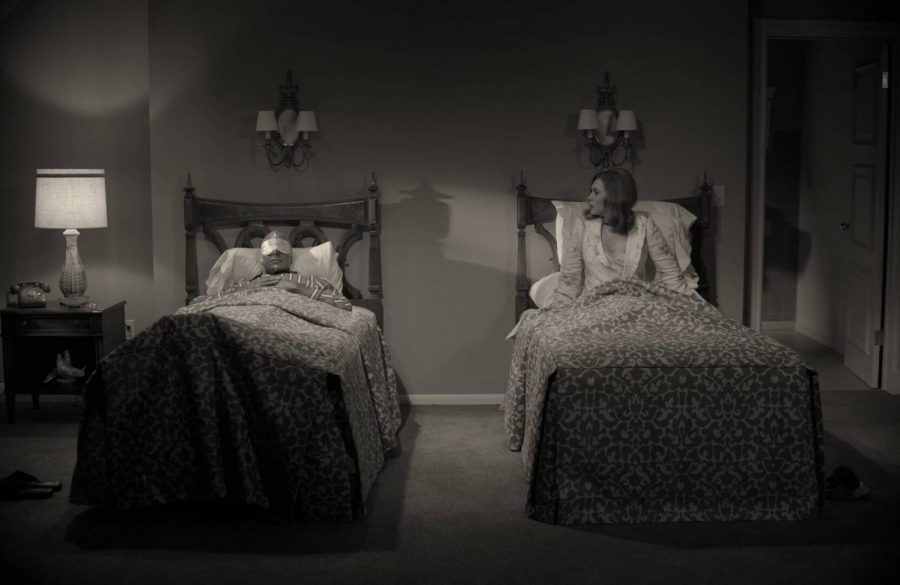With “WandaVision,” Marvel gets closer to dominating our pop culture lives
Wanda and Vision. “WandaVision.” The Marvel couple travel through TV sitcom history in their new Disney+ show.
January 29, 2021
2020 was a remarkable year in many aspects, with the pandemic fundamentally changing how we interact with one another. One of the many casualties of these changes was movie theaters, with their inherent nature making them perfect festering grounds for the coronavirus. Their subsequent shutdowns meant that, for the first time in decades, we had a year with no blockbusters, and therefore, no Marvel films.
Since 2010, new Marvel superhero films have released on at least a yearly basis, with often two or three films coming out each year to build the shared universe that all the characters inhabit. This all built up to the 2019 mega-hit “Avengers: Endgame,” which concluded a 22-film storyline and was the highest-grossing movie of all time. The entire franchise has been extremely profitable, with the “Marvel Cinematic Universe” (MCU), as it is known, surpassing “Star Wars” to become the highest-grossing film series ever. Even though “Endgame” concluded the storyline known as the “Infinity Saga,” just a few months later, “Spider-Man: Far From Home” released, planting seeds for the future and showing that there are still many more stories to tell about our super-powered friends.
And then, the well-oiled Marvel machine ground to a halt. “Black Widow,” a film starring Scarlett Johanson as the titular spy, was set to release in May of 2020 but then was delayed indefinitely, along with “The Eternals,” which was set to release in November, 2020. As such a year without a Marvel release was regarded by many to be a “pop culture void,” with the absence of the usual discussions and speculation that usually accompany the films, making a marked difference in our pop culture conversations.
Now it seems Marvel is revved up and ready to go, releasing their first bit of content in over a year with the Disney Plus series, “WandaVision.” For a first release after such a hiatus, you really couldn’t have gone with a stranger choice.
“WandaVision” is Marvel’s first true foray into making a live-action television series directly linked to their universe. While there have been shows like ABC’s “Agents of Shield” and Netflix’s “Daredevil” that are technically part of the MCU, “WandaVision” marks the first to be utilizing the high-profile characters that were part of the films previously and the first to be produced by Marvel Studios itself, rather than being outsourced. As such, it is far more integrated into the ongoing storyline of the Marvel films than previous shows, making it a much-watch for those who want to keep up.
Releasing every Friday until March 5, the show follows Wanda Maximoff, “The Scarlet Witch,” and her android husband named Vision, who died in 2018’s “Avengers: Infinity War” but has inexplicably returned. This is one of many mysteries that surround the show, where the two characters are seemingly trapped in a television sitcom reality, with each episode taking inspiration from a different decade while the two lovers spend time in a stereotypical suburb.
The first episode was an homage of ‘50s sitcoms like “I Love Lucy” and “Leave It to Beaver,” the second episode of ‘60s sitcoms like “The Dick Van Dyke Show” and “Bewitched,” the third episode of ‘70s sitcoms like “All in the Family” and “The Brady Bunch,” etc. As the decades change, so do the tropes, like Wanda and Vision having separate beds in the ‘50s episode and all the women in the small town hosting a charity magic show in the ‘60s episode. Not only that, but the actual format of the show also changes, with some episodes being black and white, some having color and the aspect ratio shifting with the times.
However, in the midst of all these charming satires, the show builds an underlying dread that increases with each episode, with genuinely creepy moments popping up here and there. While there is nothing genuinely “Lynchian,” as some critics have said in their favorable comparisons between the show and the surrealistic nightmares of David Lynch films, the show does a fine job building suspense and keeping the audience engaged, all while filling the show with charming moments throughout. All this combines to make one of the most genuinely interesting Marvel products. While it isn’t quite prestige television, it is quite a debut for this new phase of Marvel content.
And boy, oh, boy will they follow. While some have compared the Marvel films to be more akin to a television series, with a continuous ongoing storyline and a focus on continuity between films, the addition of actual television series that are integral to the overarching narrative means the Marvel pump will now be flowing nonstop. You see, two weeks after this show concludes in March, “The Falcon and the Winter Soldier,” another Disney+ series, will arrive with weekly releases. Three weeks after that concludes, “Black Widow” will finally release in theaters, barring any future delays, and that same month “Loki,” yet another Disney+ series, will premiere, running until “Shang-Chi and The Legend of The Ten Rings” opens in theaters in July.
All in all, we have a flood of Marvel content to look forward to in the coming year. If we had a pop culture drought in 2020, we will have a deluge in 2021. This brings us even closer to the format that Marvel originated from: comic books. Comic books have been released on a weekly basis for decades, building storylines and crossovers across titles as different characters’ storylines intersect. While Marvel films already followed that general plot construction formula to great success, now the rate of content will be the same. If the films and television series continue the general sense of quality, there is no reason to think that this new venture will fail.
All this is to say that this is Marvel’s world now; we’re all just living in it.



